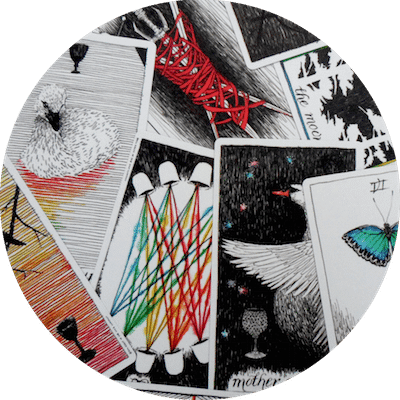You’ve gotten your feet wet reading the Tarot, and now you want to take the next step in becoming a Tarot reader. How should you get to the next level? A great way to advance your practice is to start a Tarot journal.
I know–you’re probably thinking the last time you kept a journal was in middle school, except then you called it a diary! But hear me out, because a Tarot journal is a bit more than that. Your tarot journal is a great place to jot down notes and record your personal thoughts, insights, observations and notes about each of the Tarot cards. This is a crucial tool to help you develop your relationship to each of the cards, which is crucial — because there are a lot of them!
Think of your Tarot journal as your personal handbook, like that little white book that comes with a new deck — except you’re the author of this one!
It’s important to keep track of the thoughts and observations you have as you learn, so that you can relate your own experience to the Tarot. Each time you pull a Tarot card, you will have an opportunity to relate that card to your gut instincts and personal intuition. There is nothing that you can find in a book that will be more valuable than that!
Understanding the Tarot in this way can inspire you and take you to new levels if you allow it.
1. Choose A Format
Do you like to jot down notes by hand, or do you prefer to write things lightening fast on your keypad? This is important to consider, because your first step is to pick a format that you would like your Tarot Journal to be. It might seem like a trivial decision, but think long and hard before you make a commitment to one form or the other.
2. What’s Your Medium?
If you prefer hand-writing your journal, take the opportunity to treat yourself and buy a journal that is lovely to look at and to write in. This will help develop a sense of ritual that will be really enjoyable as you learn. In addition to your main Tarot Journal, you might want to pick up a small notebook or notepad to take with you when you’re on the go, just in case you have any sudden Tarot insights or epiphanies while you’re out in the world!
But if find yourself already using your phone frequently to take notes while you’re out and about, you might want to consider keeping your Tarot journal online in a program like Google Docs, that you can access with your mobile phone, laptop or computer and that will update in real time. There are plenty of note taking apps that would be perfect for Tarot journaling, so don’t be hesitant to embrace technology on your Tarot journey.
Some people are best able to access their intuition when writing notes out long hand, while others will prefer the convenience of having their notebook accessible from any computer or mobile phone. It’s up to you.
3. What to Write
There are so many things to note and learn in every Tarot reading, and all of them are fair game. What’s important is to record what feels relevant to you. The bulk of your notes will likely be on the cards themselves. Be sure to take the time to jot down your first impression of the card, and to make a detailed description of the characters, symbols, and landscape. Go even deeper and write down the card’s corresponding astrological sign, element, and numerological suit. Keywords that you think up on your own or find in books are great, too, and if the card reminds you of any person, event, or experience, be sure to take note of that.
4. Specific Readings
You can also use your journal to take notes on specific readings. Things to record for a reading include the layout, the individual cards you drew, and what positions they appeared in. Recording a reading will help you remember all of the insights you had during a reading, and give you a chance to attain some extra insight when you review your notes later on. It can be especially useful to look at it a couple of months later and see where you went right and where you went wrong.
5. Keep Track Of New Spreads You Use
Another good thing to use your Tarot journal for is to keep track of any new spreads you have created. You might not start to do this until you are more advanced, but once you do get into the habit of custom making your spread, you may want to write about what influenced you, and how you went about creating it. You may also want to adapt and re-work previous spreads you have created.
For beginning readers, a Tarot journal is an excellent place to really start making sense of the Tarot, and relating to it on a more advanced level. For more advanced readers, the Tarot Journal can open new doors and perspectives that the reader may have never been aware of. There is always something new to learn in the Tarot!
Image of tarot cards by The Wild Unknown via Samhain Moon.


